A Report on Policy Analysis for Zero Fare Public Transport in Perth
VerifiedAdded on 2020/03/16
|11
|2613
|220
Report
AI Summary
This report provides a comprehensive analysis of a zero-fare public transport policy for Perth, Australia. It begins with an introduction highlighting the need for such a policy to reduce traffic congestion and improve the environment. The report evaluates the proposed policy's financial feasibility, considering operational costs and revenue impacts. It then reviews relevant literature, including case studies from cities like Tallinn, which have implemented similar systems. The analysis examines the policy's potential effects on ridership, service quality, and community goals. Furthermore, it explores existing and alternative fare-free public transport policies, offering recommendations for Perth's specific context. The report emphasizes the importance of maintaining service quality, managing costs, and addressing potential challenges like overcrowding. The analysis suggests strategies to ensure the long-term success of the policy, including regular customer satisfaction surveys and a focus on environmental sustainability. The report concludes by acknowledging the potential benefits and challenges of zero-fare public transport, emphasizing the need for careful planning and implementation.
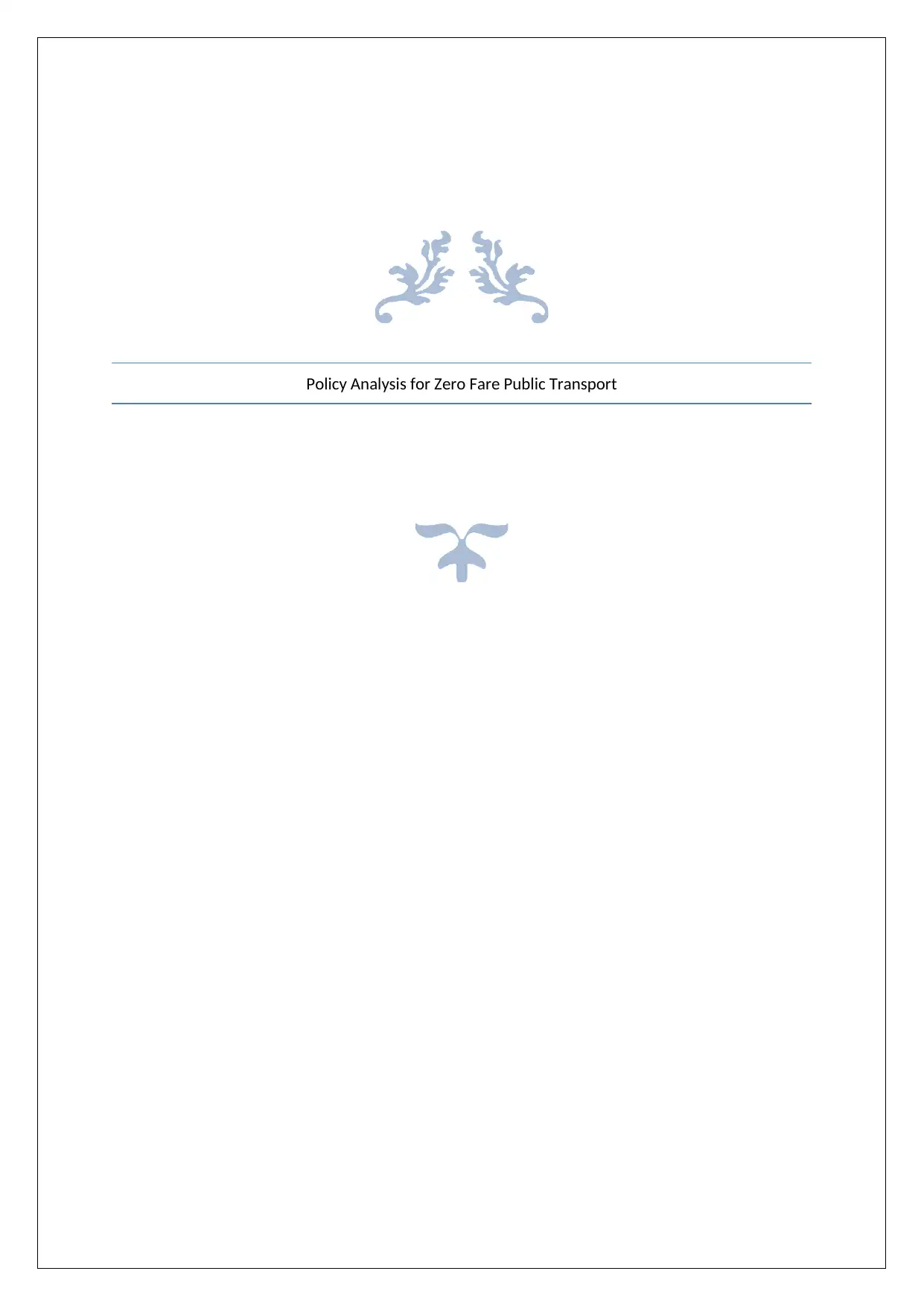
Policy Analysis for Zero Fare Public Transport
Paraphrase This Document
Need a fresh take? Get an instant paraphrase of this document with our AI Paraphraser
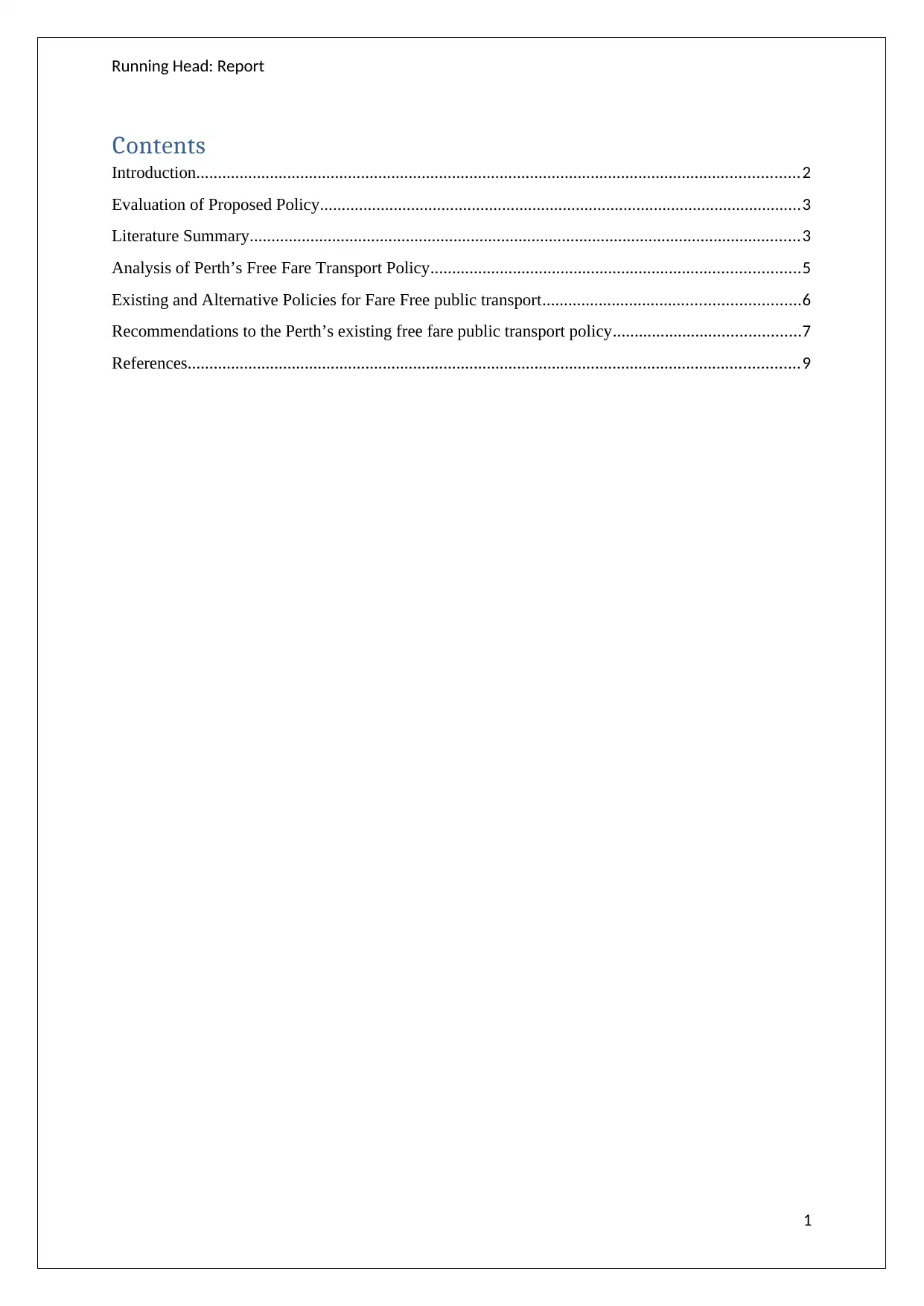
Running Head: Report
Contents
Introduction...........................................................................................................................................2
Evaluation of Proposed Policy...............................................................................................................3
Literature Summary...............................................................................................................................3
Analysis of Perth’s Free Fare Transport Policy.....................................................................................5
Existing and Alternative Policies for Fare Free public transport...........................................................6
Recommendations to the Perth’s existing free fare public transport policy...........................................7
References.............................................................................................................................................9
1
Contents
Introduction...........................................................................................................................................2
Evaluation of Proposed Policy...............................................................................................................3
Literature Summary...............................................................................................................................3
Analysis of Perth’s Free Fare Transport Policy.....................................................................................5
Existing and Alternative Policies for Fare Free public transport...........................................................6
Recommendations to the Perth’s existing free fare public transport policy...........................................7
References.............................................................................................................................................9
1
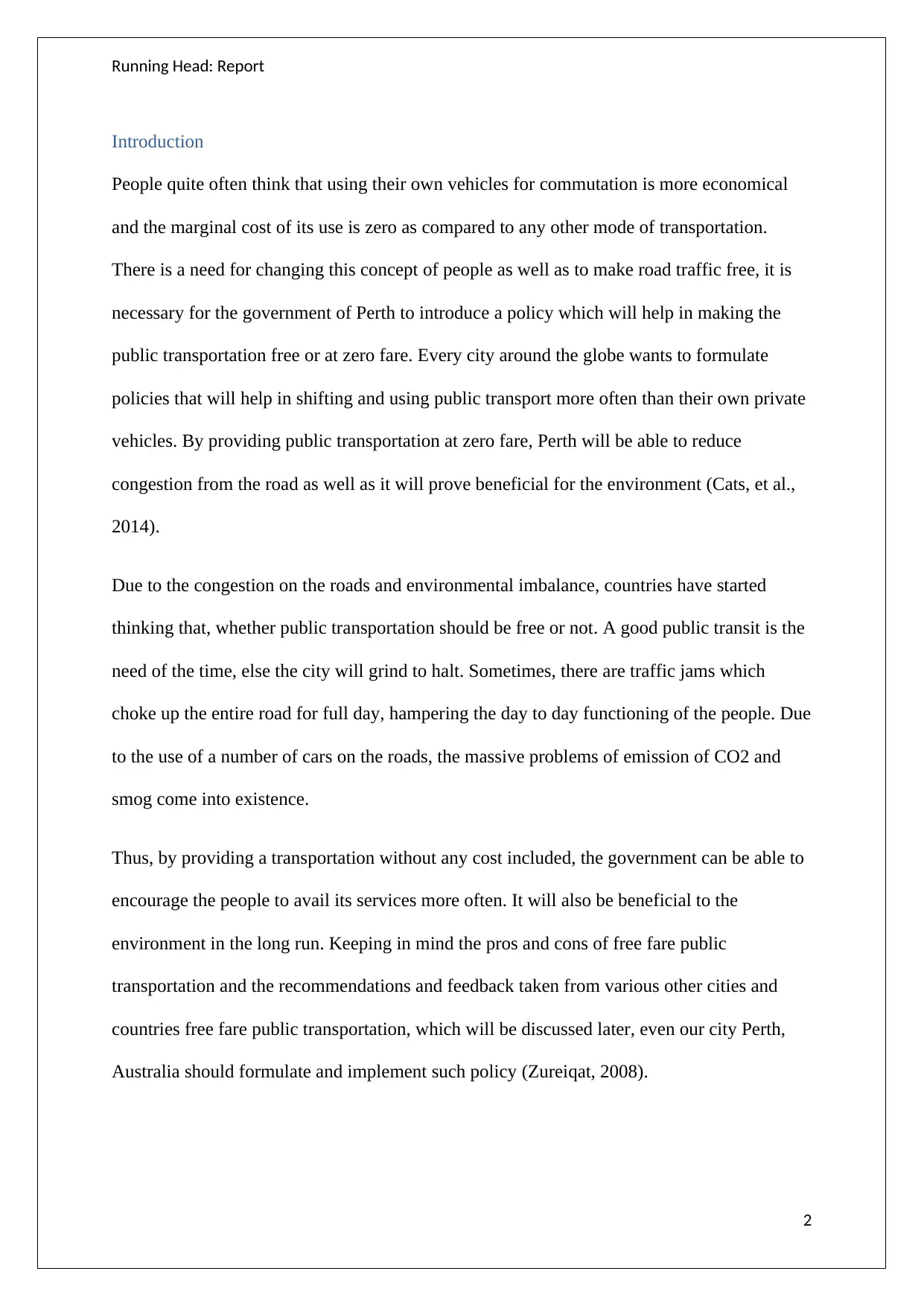
Running Head: Report
Introduction
People quite often think that using their own vehicles for commutation is more economical
and the marginal cost of its use is zero as compared to any other mode of transportation.
There is a need for changing this concept of people as well as to make road traffic free, it is
necessary for the government of Perth to introduce a policy which will help in making the
public transportation free or at zero fare. Every city around the globe wants to formulate
policies that will help in shifting and using public transport more often than their own private
vehicles. By providing public transportation at zero fare, Perth will be able to reduce
congestion from the road as well as it will prove beneficial for the environment (Cats, et al.,
2014).
Due to the congestion on the roads and environmental imbalance, countries have started
thinking that, whether public transportation should be free or not. A good public transit is the
need of the time, else the city will grind to halt. Sometimes, there are traffic jams which
choke up the entire road for full day, hampering the day to day functioning of the people. Due
to the use of a number of cars on the roads, the massive problems of emission of CO2 and
smog come into existence.
Thus, by providing a transportation without any cost included, the government can be able to
encourage the people to avail its services more often. It will also be beneficial to the
environment in the long run. Keeping in mind the pros and cons of free fare public
transportation and the recommendations and feedback taken from various other cities and
countries free fare public transportation, which will be discussed later, even our city Perth,
Australia should formulate and implement such policy (Zureiqat, 2008).
2
Introduction
People quite often think that using their own vehicles for commutation is more economical
and the marginal cost of its use is zero as compared to any other mode of transportation.
There is a need for changing this concept of people as well as to make road traffic free, it is
necessary for the government of Perth to introduce a policy which will help in making the
public transportation free or at zero fare. Every city around the globe wants to formulate
policies that will help in shifting and using public transport more often than their own private
vehicles. By providing public transportation at zero fare, Perth will be able to reduce
congestion from the road as well as it will prove beneficial for the environment (Cats, et al.,
2014).
Due to the congestion on the roads and environmental imbalance, countries have started
thinking that, whether public transportation should be free or not. A good public transit is the
need of the time, else the city will grind to halt. Sometimes, there are traffic jams which
choke up the entire road for full day, hampering the day to day functioning of the people. Due
to the use of a number of cars on the roads, the massive problems of emission of CO2 and
smog come into existence.
Thus, by providing a transportation without any cost included, the government can be able to
encourage the people to avail its services more often. It will also be beneficial to the
environment in the long run. Keeping in mind the pros and cons of free fare public
transportation and the recommendations and feedback taken from various other cities and
countries free fare public transportation, which will be discussed later, even our city Perth,
Australia should formulate and implement such policy (Zureiqat, 2008).
2
⊘ This is a preview!⊘
Do you want full access?
Subscribe today to unlock all pages.

Trusted by 1+ million students worldwide
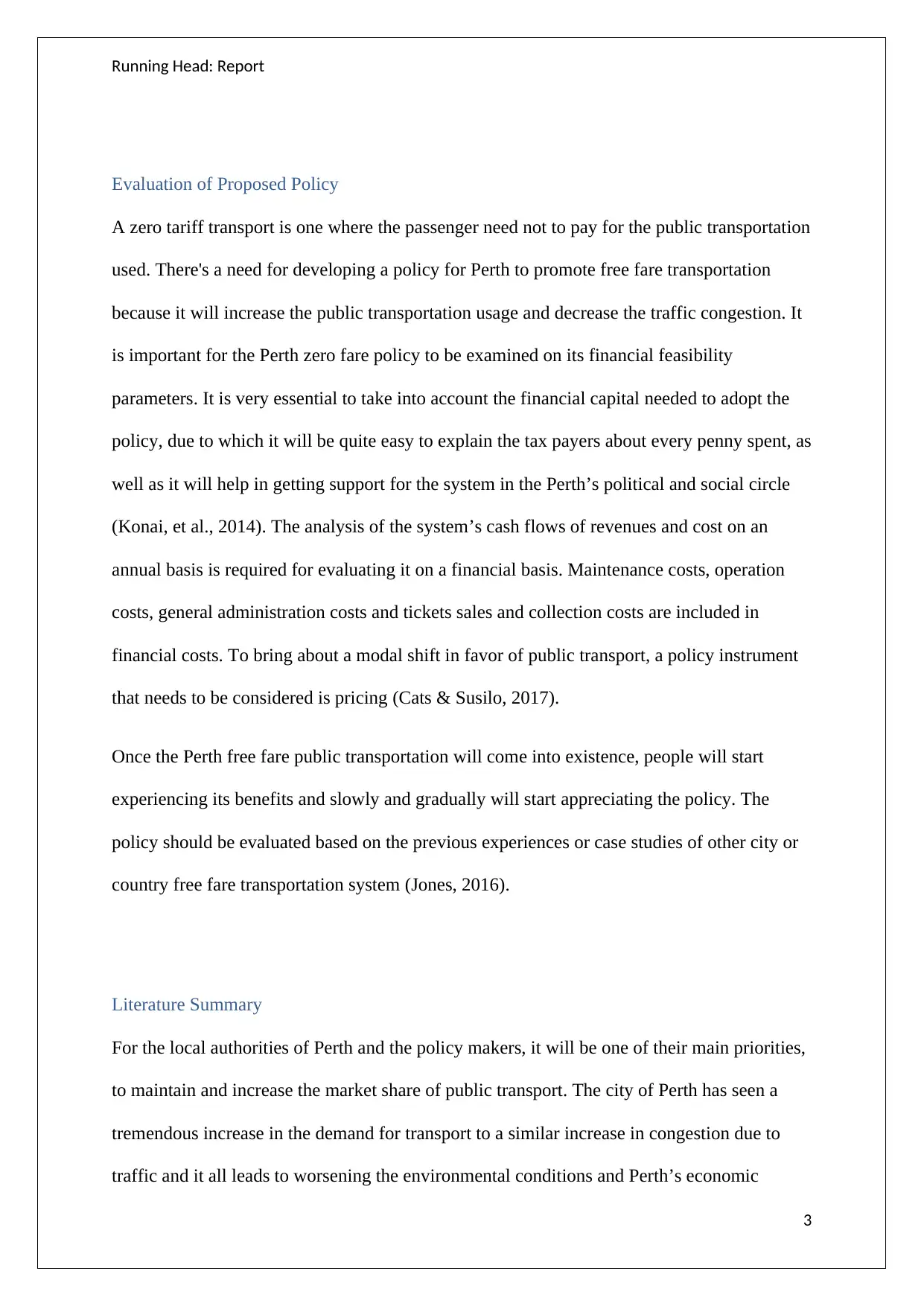
Running Head: Report
Evaluation of Proposed Policy
A zero tariff transport is one where the passenger need not to pay for the public transportation
used. There's a need for developing a policy for Perth to promote free fare transportation
because it will increase the public transportation usage and decrease the traffic congestion. It
is important for the Perth zero fare policy to be examined on its financial feasibility
parameters. It is very essential to take into account the financial capital needed to adopt the
policy, due to which it will be quite easy to explain the tax payers about every penny spent, as
well as it will help in getting support for the system in the Perth’s political and social circle
(Konai, et al., 2014). The analysis of the system’s cash flows of revenues and cost on an
annual basis is required for evaluating it on a financial basis. Maintenance costs, operation
costs, general administration costs and tickets sales and collection costs are included in
financial costs. To bring about a modal shift in favor of public transport, a policy instrument
that needs to be considered is pricing (Cats & Susilo, 2017).
Once the Perth free fare public transportation will come into existence, people will start
experiencing its benefits and slowly and gradually will start appreciating the policy. The
policy should be evaluated based on the previous experiences or case studies of other city or
country free fare transportation system (Jones, 2016).
Literature Summary
For the local authorities of Perth and the policy makers, it will be one of their main priorities,
to maintain and increase the market share of public transport. The city of Perth has seen a
tremendous increase in the demand for transport to a similar increase in congestion due to
traffic and it all leads to worsening the environmental conditions and Perth’s economic
3
Evaluation of Proposed Policy
A zero tariff transport is one where the passenger need not to pay for the public transportation
used. There's a need for developing a policy for Perth to promote free fare transportation
because it will increase the public transportation usage and decrease the traffic congestion. It
is important for the Perth zero fare policy to be examined on its financial feasibility
parameters. It is very essential to take into account the financial capital needed to adopt the
policy, due to which it will be quite easy to explain the tax payers about every penny spent, as
well as it will help in getting support for the system in the Perth’s political and social circle
(Konai, et al., 2014). The analysis of the system’s cash flows of revenues and cost on an
annual basis is required for evaluating it on a financial basis. Maintenance costs, operation
costs, general administration costs and tickets sales and collection costs are included in
financial costs. To bring about a modal shift in favor of public transport, a policy instrument
that needs to be considered is pricing (Cats & Susilo, 2017).
Once the Perth free fare public transportation will come into existence, people will start
experiencing its benefits and slowly and gradually will start appreciating the policy. The
policy should be evaluated based on the previous experiences or case studies of other city or
country free fare transportation system (Jones, 2016).
Literature Summary
For the local authorities of Perth and the policy makers, it will be one of their main priorities,
to maintain and increase the market share of public transport. The city of Perth has seen a
tremendous increase in the demand for transport to a similar increase in congestion due to
traffic and it all leads to worsening the environmental conditions and Perth’s economic
3
Paraphrase This Document
Need a fresh take? Get an instant paraphrase of this document with our AI Paraphraser
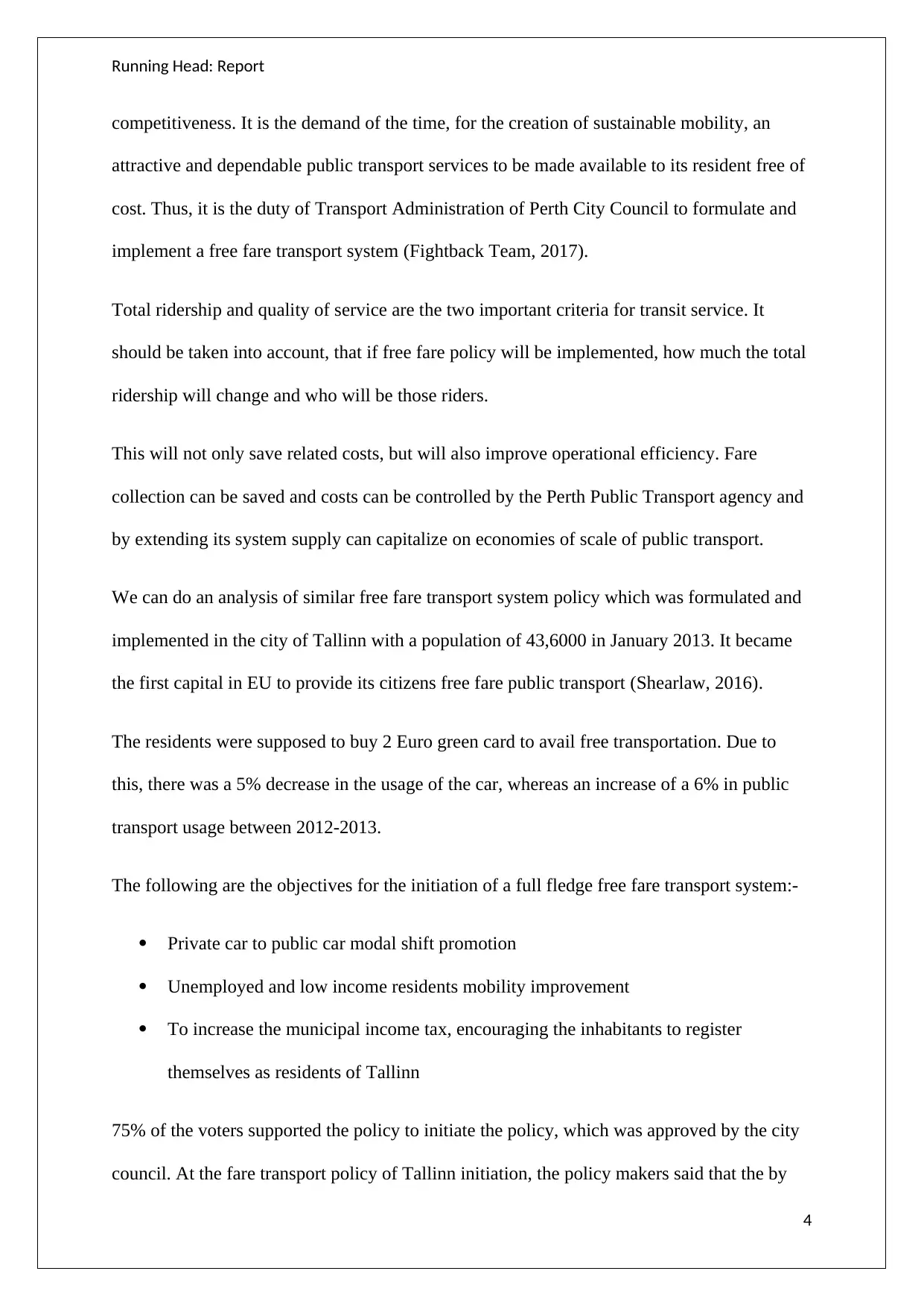
Running Head: Report
competitiveness. It is the demand of the time, for the creation of sustainable mobility, an
attractive and dependable public transport services to be made available to its resident free of
cost. Thus, it is the duty of Transport Administration of Perth City Council to formulate and
implement a free fare transport system (Fightback Team, 2017).
Total ridership and quality of service are the two important criteria for transit service. It
should be taken into account, that if free fare policy will be implemented, how much the total
ridership will change and who will be those riders.
This will not only save related costs, but will also improve operational efficiency. Fare
collection can be saved and costs can be controlled by the Perth Public Transport agency and
by extending its system supply can capitalize on economies of scale of public transport.
We can do an analysis of similar free fare transport system policy which was formulated and
implemented in the city of Tallinn with a population of 43,6000 in January 2013. It became
the first capital in EU to provide its citizens free fare public transport (Shearlaw, 2016).
The residents were supposed to buy 2 Euro green card to avail free transportation. Due to
this, there was a 5% decrease in the usage of the car, whereas an increase of a 6% in public
transport usage between 2012-2013.
The following are the objectives for the initiation of a full fledge free fare transport system:-
Private car to public car modal shift promotion
Unemployed and low income residents mobility improvement
To increase the municipal income tax, encouraging the inhabitants to register
themselves as residents of Tallinn
75% of the voters supported the policy to initiate the policy, which was approved by the city
council. At the fare transport policy of Tallinn initiation, the policy makers said that the by
4
competitiveness. It is the demand of the time, for the creation of sustainable mobility, an
attractive and dependable public transport services to be made available to its resident free of
cost. Thus, it is the duty of Transport Administration of Perth City Council to formulate and
implement a free fare transport system (Fightback Team, 2017).
Total ridership and quality of service are the two important criteria for transit service. It
should be taken into account, that if free fare policy will be implemented, how much the total
ridership will change and who will be those riders.
This will not only save related costs, but will also improve operational efficiency. Fare
collection can be saved and costs can be controlled by the Perth Public Transport agency and
by extending its system supply can capitalize on economies of scale of public transport.
We can do an analysis of similar free fare transport system policy which was formulated and
implemented in the city of Tallinn with a population of 43,6000 in January 2013. It became
the first capital in EU to provide its citizens free fare public transport (Shearlaw, 2016).
The residents were supposed to buy 2 Euro green card to avail free transportation. Due to
this, there was a 5% decrease in the usage of the car, whereas an increase of a 6% in public
transport usage between 2012-2013.
The following are the objectives for the initiation of a full fledge free fare transport system:-
Private car to public car modal shift promotion
Unemployed and low income residents mobility improvement
To increase the municipal income tax, encouraging the inhabitants to register
themselves as residents of Tallinn
75% of the voters supported the policy to initiate the policy, which was approved by the city
council. At the fare transport policy of Tallinn initiation, the policy makers said that the by
4
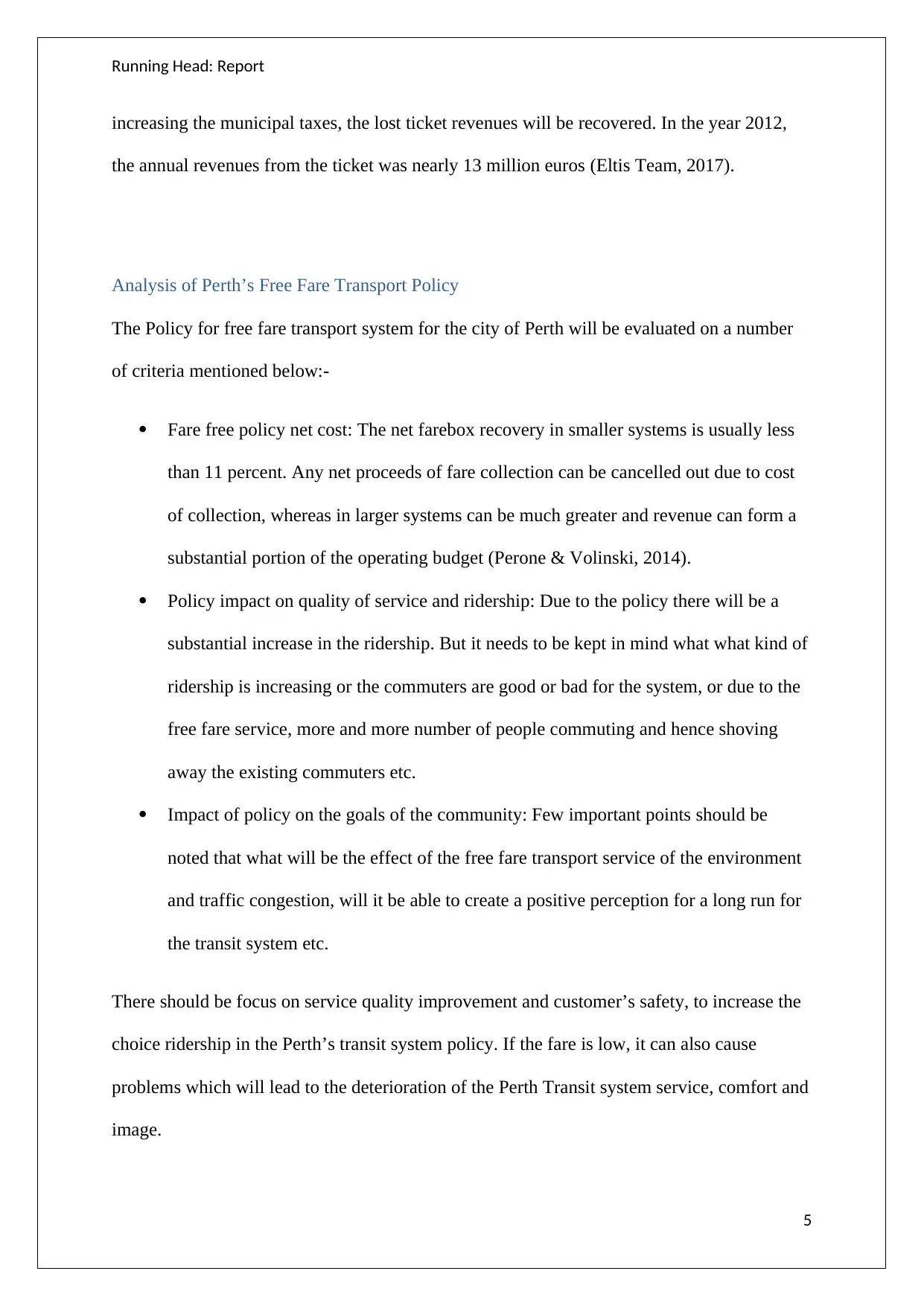
Running Head: Report
increasing the municipal taxes, the lost ticket revenues will be recovered. In the year 2012,
the annual revenues from the ticket was nearly 13 million euros (Eltis Team, 2017).
Analysis of Perth’s Free Fare Transport Policy
The Policy for free fare transport system for the city of Perth will be evaluated on a number
of criteria mentioned below:-
Fare free policy net cost: The net farebox recovery in smaller systems is usually less
than 11 percent. Any net proceeds of fare collection can be cancelled out due to cost
of collection, whereas in larger systems can be much greater and revenue can form a
substantial portion of the operating budget (Perone & Volinski, 2014).
Policy impact on quality of service and ridership: Due to the policy there will be a
substantial increase in the ridership. But it needs to be kept in mind what what kind of
ridership is increasing or the commuters are good or bad for the system, or due to the
free fare service, more and more number of people commuting and hence shoving
away the existing commuters etc.
Impact of policy on the goals of the community: Few important points should be
noted that what will be the effect of the free fare transport service of the environment
and traffic congestion, will it be able to create a positive perception for a long run for
the transit system etc.
There should be focus on service quality improvement and customer’s safety, to increase the
choice ridership in the Perth’s transit system policy. If the fare is low, it can also cause
problems which will lead to the deterioration of the Perth Transit system service, comfort and
image.
5
increasing the municipal taxes, the lost ticket revenues will be recovered. In the year 2012,
the annual revenues from the ticket was nearly 13 million euros (Eltis Team, 2017).
Analysis of Perth’s Free Fare Transport Policy
The Policy for free fare transport system for the city of Perth will be evaluated on a number
of criteria mentioned below:-
Fare free policy net cost: The net farebox recovery in smaller systems is usually less
than 11 percent. Any net proceeds of fare collection can be cancelled out due to cost
of collection, whereas in larger systems can be much greater and revenue can form a
substantial portion of the operating budget (Perone & Volinski, 2014).
Policy impact on quality of service and ridership: Due to the policy there will be a
substantial increase in the ridership. But it needs to be kept in mind what what kind of
ridership is increasing or the commuters are good or bad for the system, or due to the
free fare service, more and more number of people commuting and hence shoving
away the existing commuters etc.
Impact of policy on the goals of the community: Few important points should be
noted that what will be the effect of the free fare transport service of the environment
and traffic congestion, will it be able to create a positive perception for a long run for
the transit system etc.
There should be focus on service quality improvement and customer’s safety, to increase the
choice ridership in the Perth’s transit system policy. If the fare is low, it can also cause
problems which will lead to the deterioration of the Perth Transit system service, comfort and
image.
5
⊘ This is a preview!⊘
Do you want full access?
Subscribe today to unlock all pages.

Trusted by 1+ million students worldwide
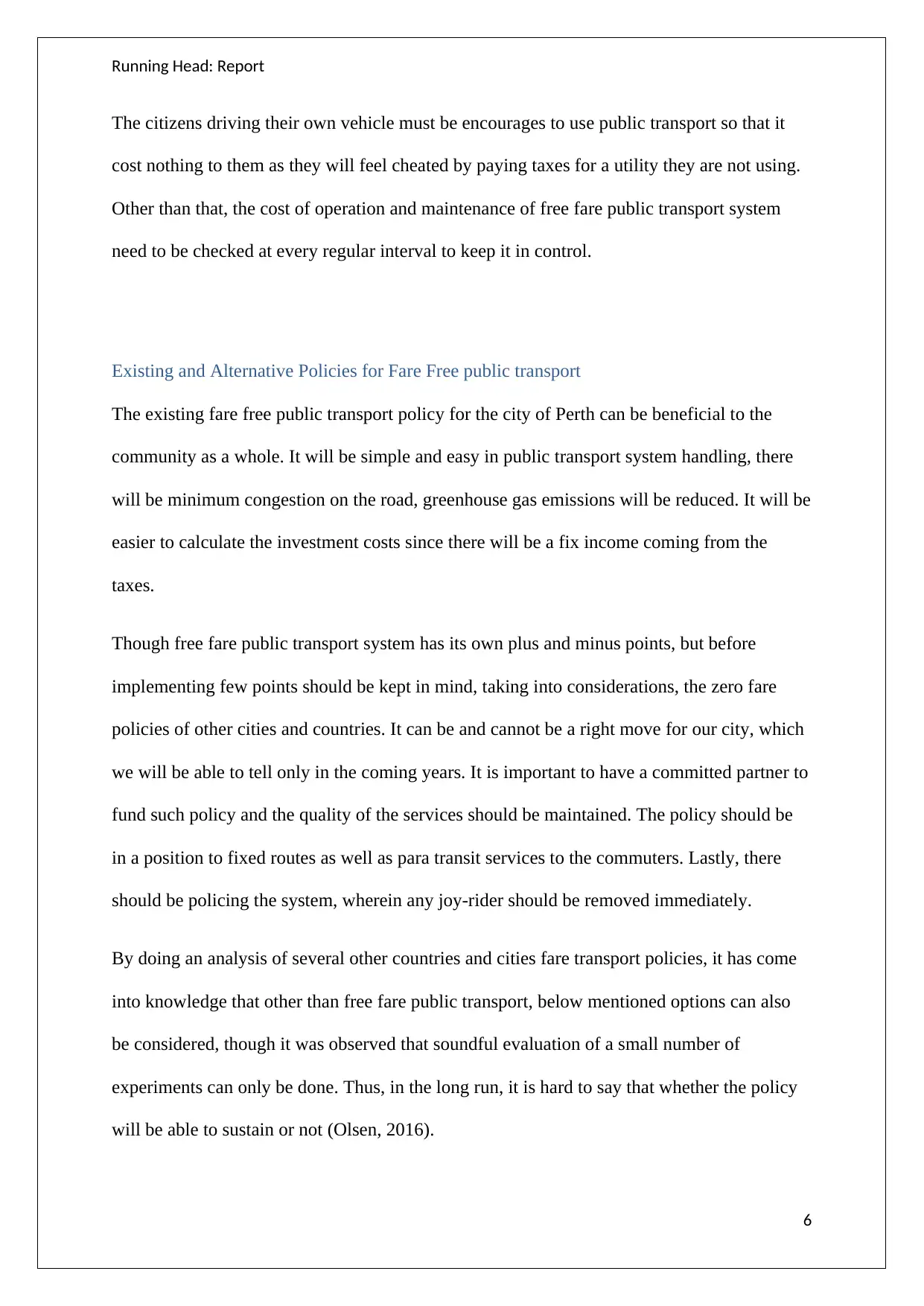
Running Head: Report
The citizens driving their own vehicle must be encourages to use public transport so that it
cost nothing to them as they will feel cheated by paying taxes for a utility they are not using.
Other than that, the cost of operation and maintenance of free fare public transport system
need to be checked at every regular interval to keep it in control.
Existing and Alternative Policies for Fare Free public transport
The existing fare free public transport policy for the city of Perth can be beneficial to the
community as a whole. It will be simple and easy in public transport system handling, there
will be minimum congestion on the road, greenhouse gas emissions will be reduced. It will be
easier to calculate the investment costs since there will be a fix income coming from the
taxes.
Though free fare public transport system has its own plus and minus points, but before
implementing few points should be kept in mind, taking into considerations, the zero fare
policies of other cities and countries. It can be and cannot be a right move for our city, which
we will be able to tell only in the coming years. It is important to have a committed partner to
fund such policy and the quality of the services should be maintained. The policy should be
in a position to fixed routes as well as para transit services to the commuters. Lastly, there
should be policing the system, wherein any joy-rider should be removed immediately.
By doing an analysis of several other countries and cities fare transport policies, it has come
into knowledge that other than free fare public transport, below mentioned options can also
be considered, though it was observed that soundful evaluation of a small number of
experiments can only be done. Thus, in the long run, it is hard to say that whether the policy
will be able to sustain or not (Olsen, 2016).
6
The citizens driving their own vehicle must be encourages to use public transport so that it
cost nothing to them as they will feel cheated by paying taxes for a utility they are not using.
Other than that, the cost of operation and maintenance of free fare public transport system
need to be checked at every regular interval to keep it in control.
Existing and Alternative Policies for Fare Free public transport
The existing fare free public transport policy for the city of Perth can be beneficial to the
community as a whole. It will be simple and easy in public transport system handling, there
will be minimum congestion on the road, greenhouse gas emissions will be reduced. It will be
easier to calculate the investment costs since there will be a fix income coming from the
taxes.
Though free fare public transport system has its own plus and minus points, but before
implementing few points should be kept in mind, taking into considerations, the zero fare
policies of other cities and countries. It can be and cannot be a right move for our city, which
we will be able to tell only in the coming years. It is important to have a committed partner to
fund such policy and the quality of the services should be maintained. The policy should be
in a position to fixed routes as well as para transit services to the commuters. Lastly, there
should be policing the system, wherein any joy-rider should be removed immediately.
By doing an analysis of several other countries and cities fare transport policies, it has come
into knowledge that other than free fare public transport, below mentioned options can also
be considered, though it was observed that soundful evaluation of a small number of
experiments can only be done. Thus, in the long run, it is hard to say that whether the policy
will be able to sustain or not (Olsen, 2016).
6
Paraphrase This Document
Need a fresh take? Get an instant paraphrase of this document with our AI Paraphraser
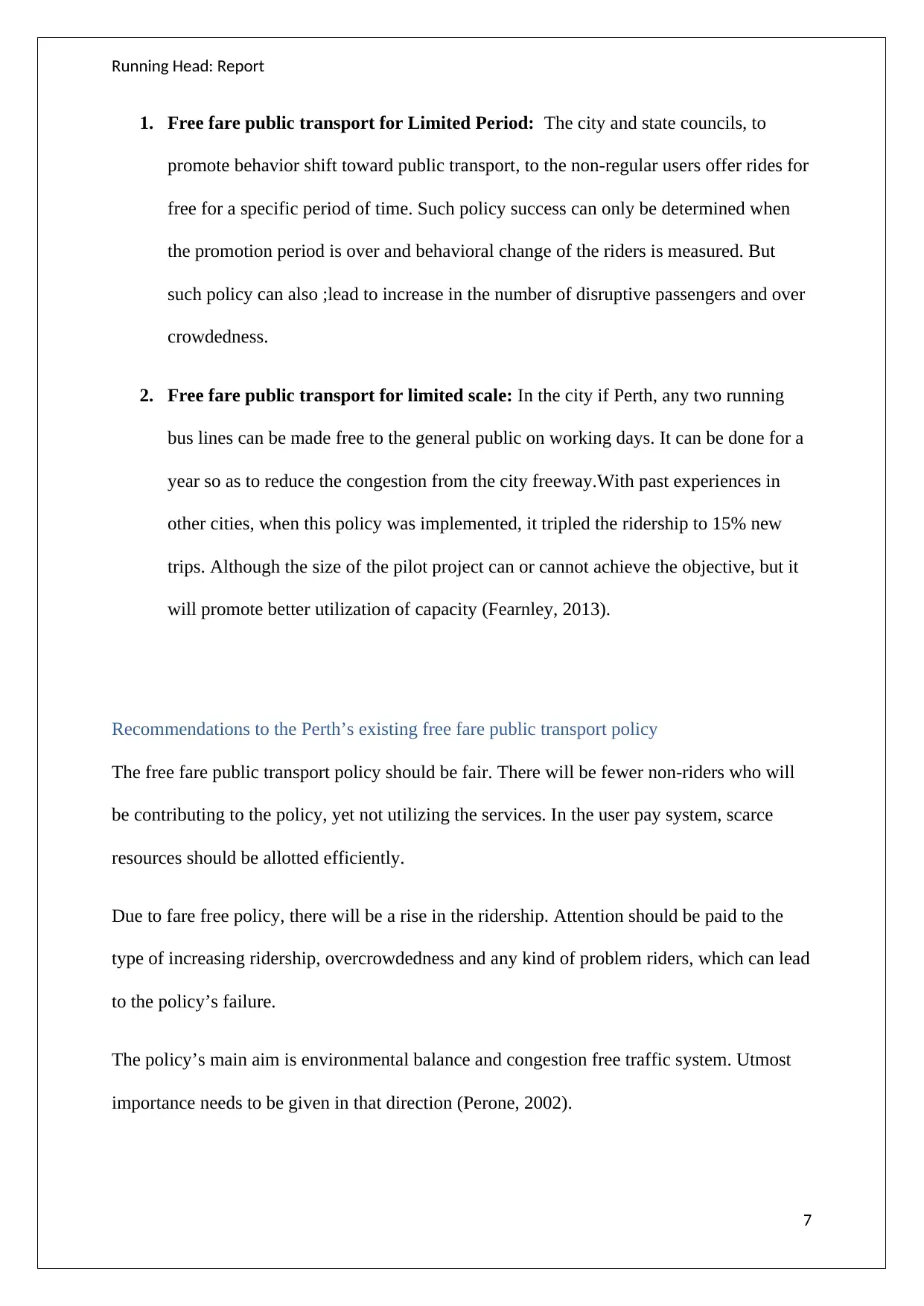
Running Head: Report
1. Free fare public transport for Limited Period: The city and state councils, to
promote behavior shift toward public transport, to the non-regular users offer rides for
free for a specific period of time. Such policy success can only be determined when
the promotion period is over and behavioral change of the riders is measured. But
such policy can also ;lead to increase in the number of disruptive passengers and over
crowdedness.
2. Free fare public transport for limited scale: In the city if Perth, any two running
bus lines can be made free to the general public on working days. It can be done for a
year so as to reduce the congestion from the city freeway.With past experiences in
other cities, when this policy was implemented, it tripled the ridership to 15% new
trips. Although the size of the pilot project can or cannot achieve the objective, but it
will promote better utilization of capacity (Fearnley, 2013).
Recommendations to the Perth’s existing free fare public transport policy
The free fare public transport policy should be fair. There will be fewer non-riders who will
be contributing to the policy, yet not utilizing the services. In the user pay system, scarce
resources should be allotted efficiently.
Due to fare free policy, there will be a rise in the ridership. Attention should be paid to the
type of increasing ridership, overcrowdedness and any kind of problem riders, which can lead
to the policy’s failure.
The policy’s main aim is environmental balance and congestion free traffic system. Utmost
importance needs to be given in that direction (Perone, 2002).
7
1. Free fare public transport for Limited Period: The city and state councils, to
promote behavior shift toward public transport, to the non-regular users offer rides for
free for a specific period of time. Such policy success can only be determined when
the promotion period is over and behavioral change of the riders is measured. But
such policy can also ;lead to increase in the number of disruptive passengers and over
crowdedness.
2. Free fare public transport for limited scale: In the city if Perth, any two running
bus lines can be made free to the general public on working days. It can be done for a
year so as to reduce the congestion from the city freeway.With past experiences in
other cities, when this policy was implemented, it tripled the ridership to 15% new
trips. Although the size of the pilot project can or cannot achieve the objective, but it
will promote better utilization of capacity (Fearnley, 2013).
Recommendations to the Perth’s existing free fare public transport policy
The free fare public transport policy should be fair. There will be fewer non-riders who will
be contributing to the policy, yet not utilizing the services. In the user pay system, scarce
resources should be allotted efficiently.
Due to fare free policy, there will be a rise in the ridership. Attention should be paid to the
type of increasing ridership, overcrowdedness and any kind of problem riders, which can lead
to the policy’s failure.
The policy’s main aim is environmental balance and congestion free traffic system. Utmost
importance needs to be given in that direction (Perone, 2002).
7
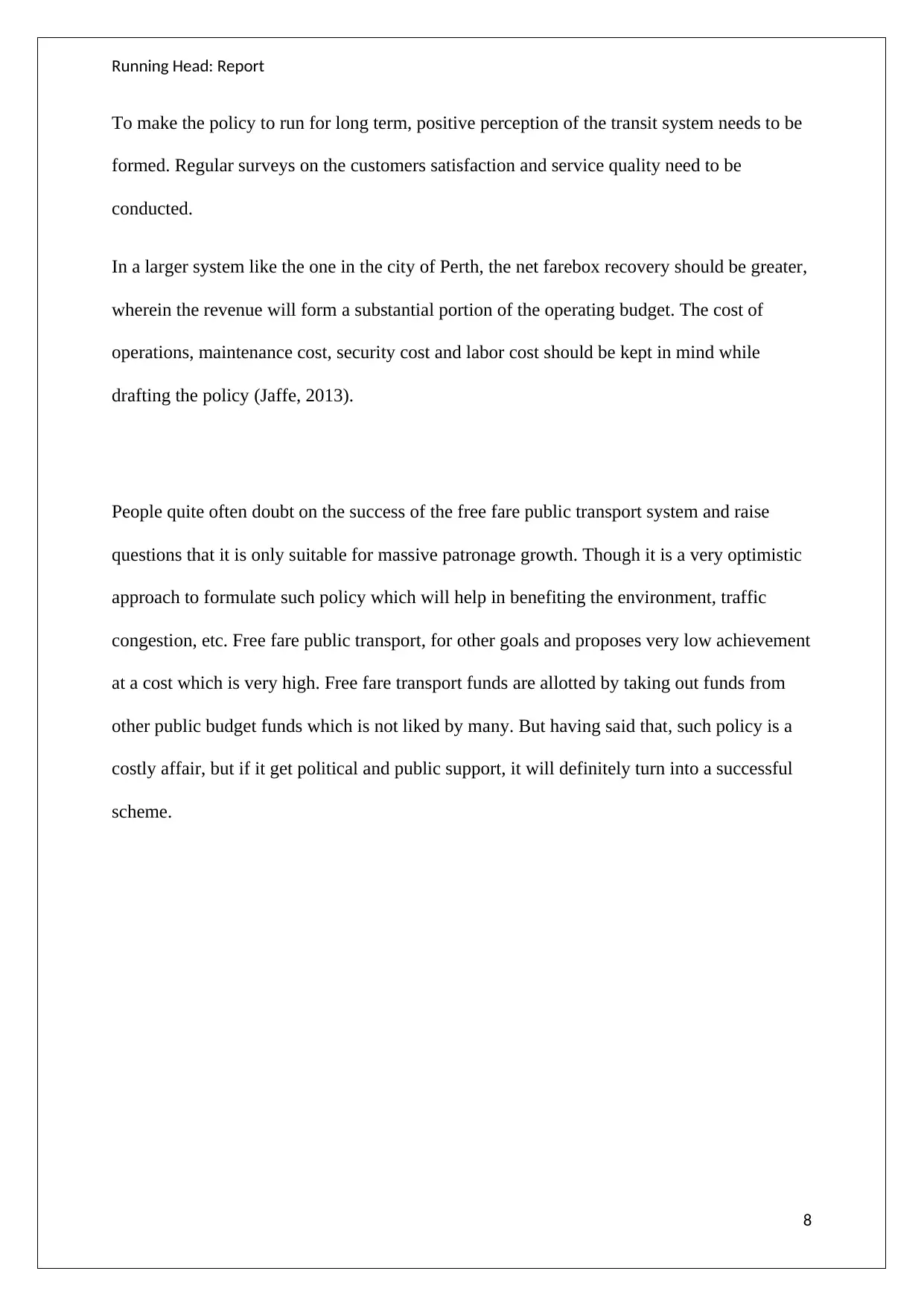
Running Head: Report
To make the policy to run for long term, positive perception of the transit system needs to be
formed. Regular surveys on the customers satisfaction and service quality need to be
conducted.
In a larger system like the one in the city of Perth, the net farebox recovery should be greater,
wherein the revenue will form a substantial portion of the operating budget. The cost of
operations, maintenance cost, security cost and labor cost should be kept in mind while
drafting the policy (Jaffe, 2013).
People quite often doubt on the success of the free fare public transport system and raise
questions that it is only suitable for massive patronage growth. Though it is a very optimistic
approach to formulate such policy which will help in benefiting the environment, traffic
congestion, etc. Free fare public transport, for other goals and proposes very low achievement
at a cost which is very high. Free fare transport funds are allotted by taking out funds from
other public budget funds which is not liked by many. But having said that, such policy is a
costly affair, but if it get political and public support, it will definitely turn into a successful
scheme.
8
To make the policy to run for long term, positive perception of the transit system needs to be
formed. Regular surveys on the customers satisfaction and service quality need to be
conducted.
In a larger system like the one in the city of Perth, the net farebox recovery should be greater,
wherein the revenue will form a substantial portion of the operating budget. The cost of
operations, maintenance cost, security cost and labor cost should be kept in mind while
drafting the policy (Jaffe, 2013).
People quite often doubt on the success of the free fare public transport system and raise
questions that it is only suitable for massive patronage growth. Though it is a very optimistic
approach to formulate such policy which will help in benefiting the environment, traffic
congestion, etc. Free fare public transport, for other goals and proposes very low achievement
at a cost which is very high. Free fare transport funds are allotted by taking out funds from
other public budget funds which is not liked by many. But having said that, such policy is a
costly affair, but if it get political and public support, it will definitely turn into a successful
scheme.
8
⊘ This is a preview!⊘
Do you want full access?
Subscribe today to unlock all pages.

Trusted by 1+ million students worldwide
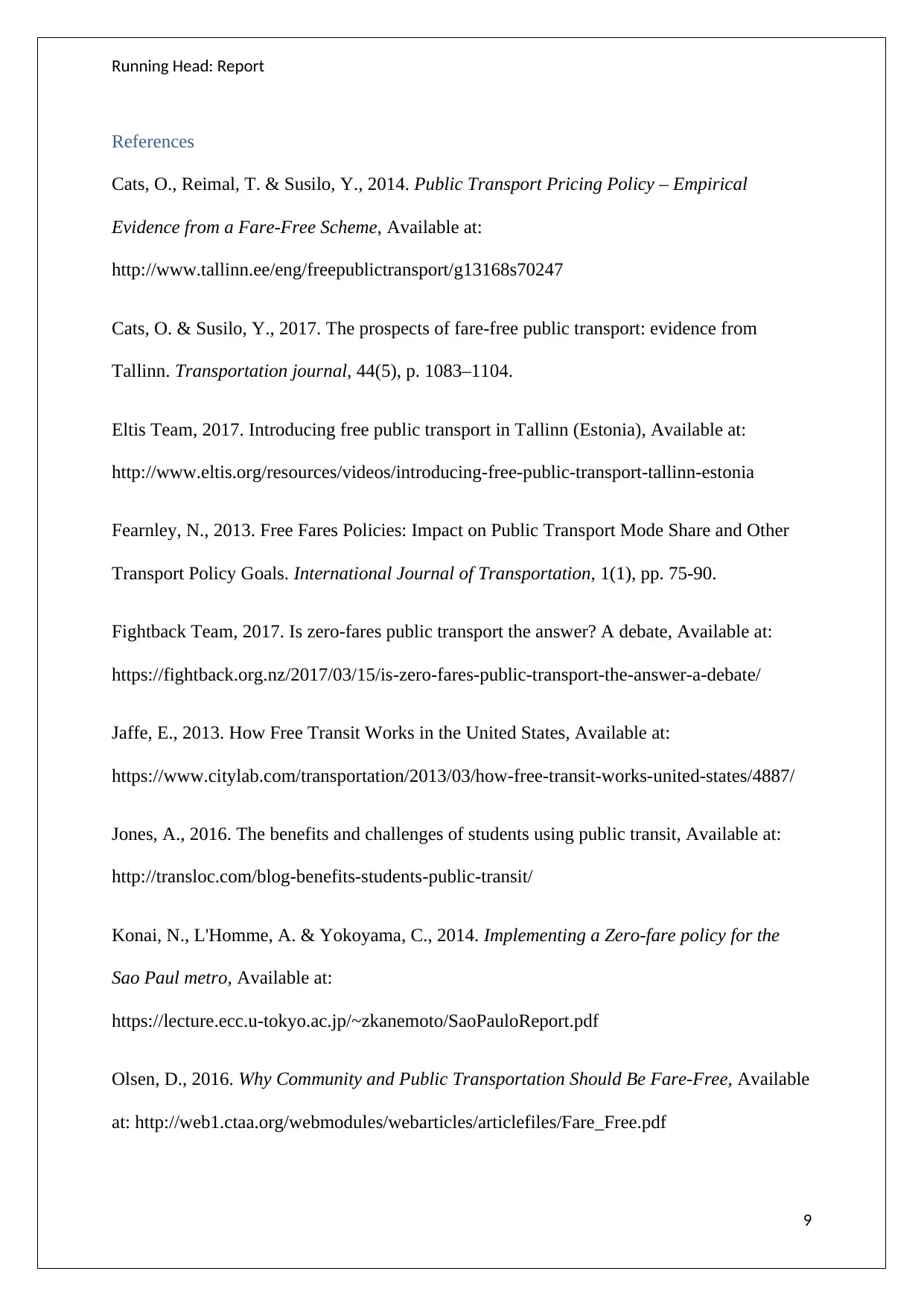
Running Head: Report
References
Cats, O., Reimal, T. & Susilo, Y., 2014. Public Transport Pricing Policy – Empirical
Evidence from a Fare-Free Scheme, Available at:
http://www.tallinn.ee/eng/freepublictransport/g13168s70247
Cats, O. & Susilo, Y., 2017. The prospects of fare-free public transport: evidence from
Tallinn. Transportation journal, 44(5), p. 1083–1104.
Eltis Team, 2017. Introducing free public transport in Tallinn (Estonia), Available at:
http://www.eltis.org/resources/videos/introducing-free-public-transport-tallinn-estonia
Fearnley, N., 2013. Free Fares Policies: Impact on Public Transport Mode Share and Other
Transport Policy Goals. International Journal of Transportation, 1(1), pp. 75-90.
Fightback Team, 2017. Is zero-fares public transport the answer? A debate, Available at:
https://fightback.org.nz/2017/03/15/is-zero-fares-public-transport-the-answer-a-debate/
Jaffe, E., 2013. How Free Transit Works in the United States, Available at:
https://www.citylab.com/transportation/2013/03/how-free-transit-works-united-states/4887/
Jones, A., 2016. The benefits and challenges of students using public transit, Available at:
http://transloc.com/blog-benefits-students-public-transit/
Konai, N., L'Homme, A. & Yokoyama, C., 2014. Implementing a Zero-fare policy for the
Sao Paul metro, Available at:
https://lecture.ecc.u-tokyo.ac.jp/~zkanemoto/SaoPauloReport.pdf
Olsen, D., 2016. Why Community and Public Transportation Should Be Fare-Free, Available
at: http://web1.ctaa.org/webmodules/webarticles/articlefiles/Fare_Free.pdf
9
References
Cats, O., Reimal, T. & Susilo, Y., 2014. Public Transport Pricing Policy – Empirical
Evidence from a Fare-Free Scheme, Available at:
http://www.tallinn.ee/eng/freepublictransport/g13168s70247
Cats, O. & Susilo, Y., 2017. The prospects of fare-free public transport: evidence from
Tallinn. Transportation journal, 44(5), p. 1083–1104.
Eltis Team, 2017. Introducing free public transport in Tallinn (Estonia), Available at:
http://www.eltis.org/resources/videos/introducing-free-public-transport-tallinn-estonia
Fearnley, N., 2013. Free Fares Policies: Impact on Public Transport Mode Share and Other
Transport Policy Goals. International Journal of Transportation, 1(1), pp. 75-90.
Fightback Team, 2017. Is zero-fares public transport the answer? A debate, Available at:
https://fightback.org.nz/2017/03/15/is-zero-fares-public-transport-the-answer-a-debate/
Jaffe, E., 2013. How Free Transit Works in the United States, Available at:
https://www.citylab.com/transportation/2013/03/how-free-transit-works-united-states/4887/
Jones, A., 2016. The benefits and challenges of students using public transit, Available at:
http://transloc.com/blog-benefits-students-public-transit/
Konai, N., L'Homme, A. & Yokoyama, C., 2014. Implementing a Zero-fare policy for the
Sao Paul metro, Available at:
https://lecture.ecc.u-tokyo.ac.jp/~zkanemoto/SaoPauloReport.pdf
Olsen, D., 2016. Why Community and Public Transportation Should Be Fare-Free, Available
at: http://web1.ctaa.org/webmodules/webarticles/articlefiles/Fare_Free.pdf
9
Paraphrase This Document
Need a fresh take? Get an instant paraphrase of this document with our AI Paraphraser
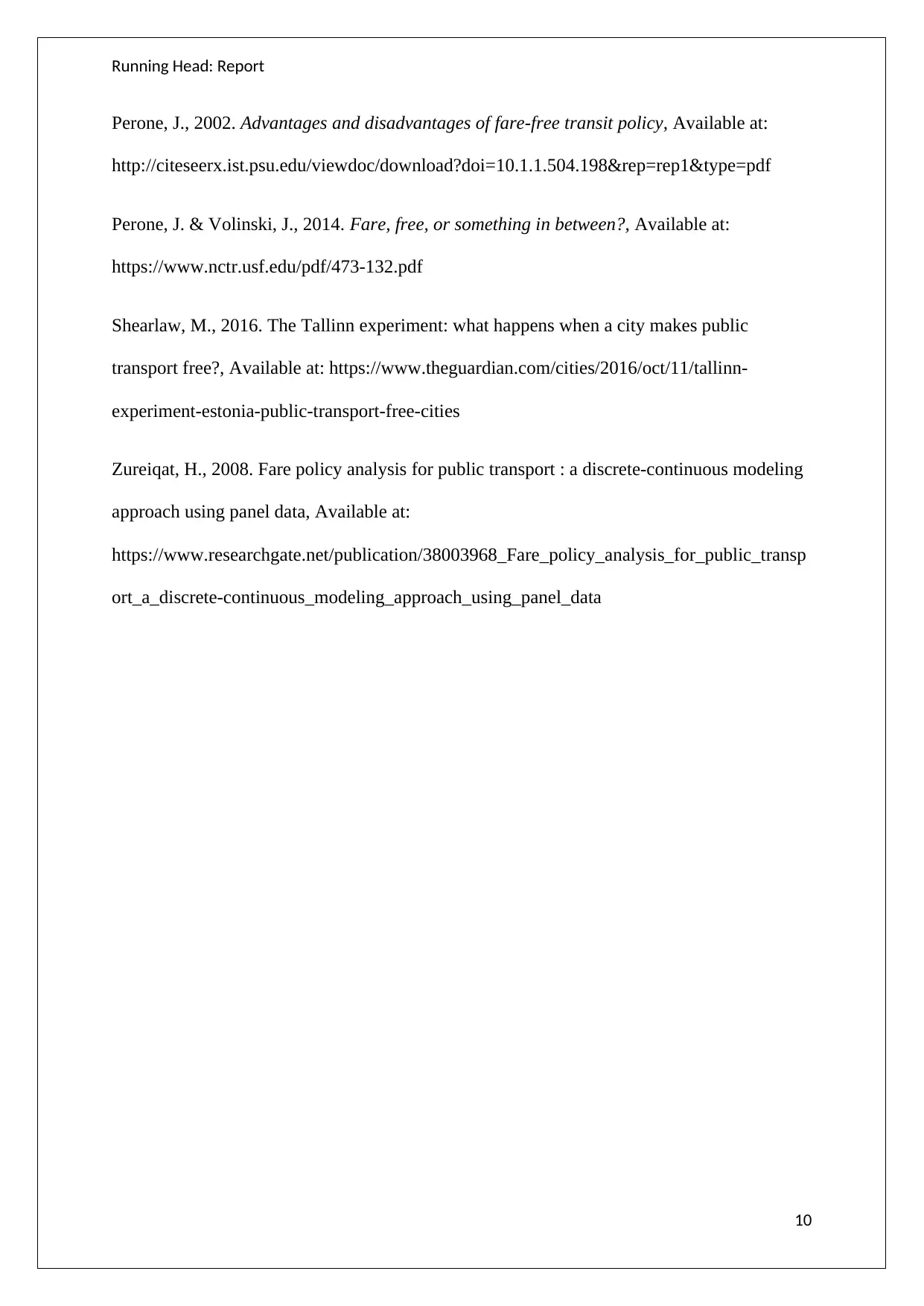
Running Head: Report
Perone, J., 2002. Advantages and disadvantages of fare-free transit policy, Available at:
http://citeseerx.ist.psu.edu/viewdoc/download?doi=10.1.1.504.198&rep=rep1&type=pdf
Perone, J. & Volinski, J., 2014. Fare, free, or something in between?, Available at:
https://www.nctr.usf.edu/pdf/473-132.pdf
Shearlaw, M., 2016. The Tallinn experiment: what happens when a city makes public
transport free?, Available at: https://www.theguardian.com/cities/2016/oct/11/tallinn-
experiment-estonia-public-transport-free-cities
Zureiqat, H., 2008. Fare policy analysis for public transport : a discrete-continuous modeling
approach using panel data, Available at:
https://www.researchgate.net/publication/38003968_Fare_policy_analysis_for_public_transp
ort_a_discrete-continuous_modeling_approach_using_panel_data
10
Perone, J., 2002. Advantages and disadvantages of fare-free transit policy, Available at:
http://citeseerx.ist.psu.edu/viewdoc/download?doi=10.1.1.504.198&rep=rep1&type=pdf
Perone, J. & Volinski, J., 2014. Fare, free, or something in between?, Available at:
https://www.nctr.usf.edu/pdf/473-132.pdf
Shearlaw, M., 2016. The Tallinn experiment: what happens when a city makes public
transport free?, Available at: https://www.theguardian.com/cities/2016/oct/11/tallinn-
experiment-estonia-public-transport-free-cities
Zureiqat, H., 2008. Fare policy analysis for public transport : a discrete-continuous modeling
approach using panel data, Available at:
https://www.researchgate.net/publication/38003968_Fare_policy_analysis_for_public_transp
ort_a_discrete-continuous_modeling_approach_using_panel_data
10
1 out of 11
Related Documents
Your All-in-One AI-Powered Toolkit for Academic Success.
+13062052269
info@desklib.com
Available 24*7 on WhatsApp / Email
![[object Object]](/_next/static/media/star-bottom.7253800d.svg)
Unlock your academic potential
Copyright © 2020–2025 A2Z Services. All Rights Reserved. Developed and managed by ZUCOL.





